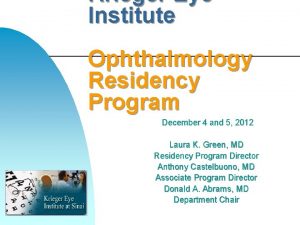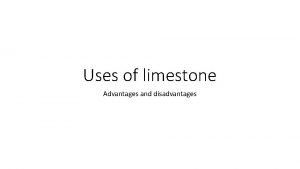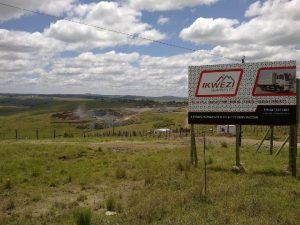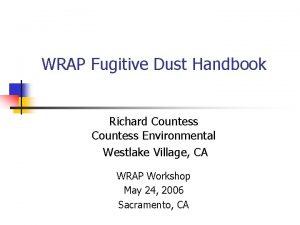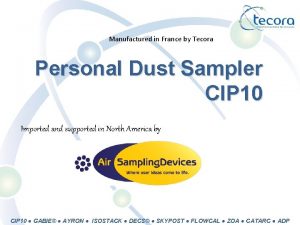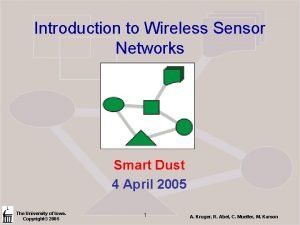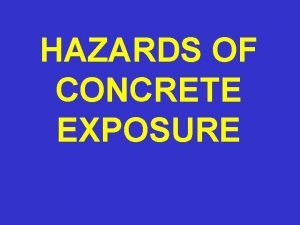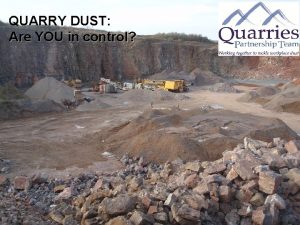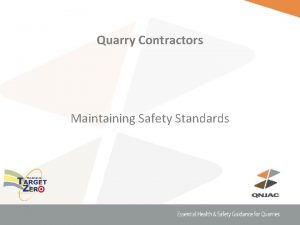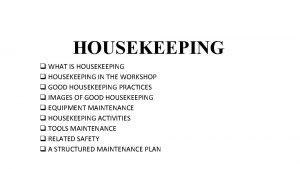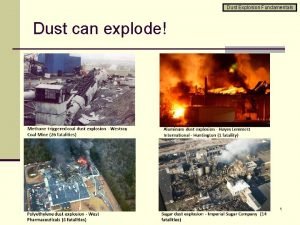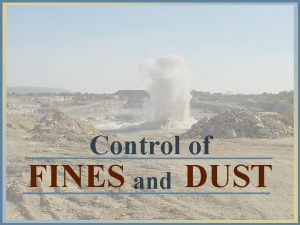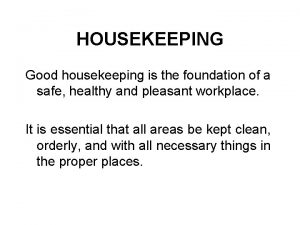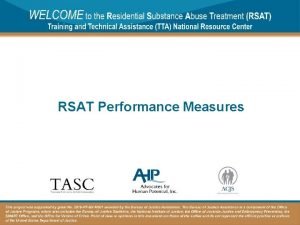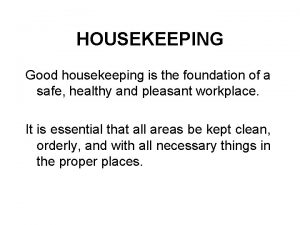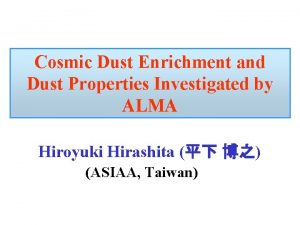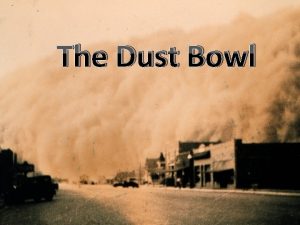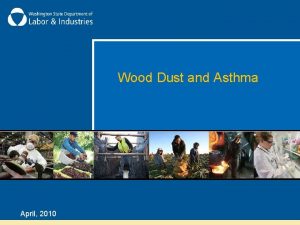QUARRY DUST Are YOU in control Housekeeping Timings





























- Slides: 29

QUARRY DUST: Are YOU in control?

Housekeeping • • Timings Evacuation procedure Toilets Switch off mobile phones please

Today’s Key learning points • Understanding silica dust; • Where might you be exposed to silica dust? ; • How silica dust could effect your body; • What can you do to control exposure to silica dust.

What is silica dust? MYTH: ‘It’s natural so it can’t be harmful’ REALITY: Natural materials can be harmful…stone dust can cause lung disease!

What is Silica dust? All dusts can be harmful if you are exposed to large quantities Some can cause a problem with continual exposures The dust that has the greatest health effect in our industry is Silica dust

Silica dust Silica is a common substance found all around us; Usually it is not a problem (sand on the beach); It can become a problem when it is processed and crushed during quarrying activities The really hazardous dust is Respirable Crystalline Silica dust that can get deep into the lungs and lead to the respiratory disease Silicosis, a severely disabling lung disease

Where might you be exposed to silica dust? MYTH: ‘of course its safe – we’ve always done it this way’ REALITY: Some diseases take years to develop. Exposure may be high because the tasks have always been done that way…. . maybe it’s time to change!

Where does exposure occur? Where do you think exposures occur: What activities do you undertake in the workplace that can lead to exposure to silica dust?

High risk activities Maintenance and cleaning Handling filler Bagging and packing Drilling & blasting Silica exposure Stone working & stock handling Loading and hauling Asphalt production Crushing and screening

Where exposure occurs Sanding without Tyndal lighting Sanding with Tyndal lighting

How exposure to silica dust can effect your body MYTH: I don’t work with harmful substances! REALITY: Most businesses work with substances that can be hazardous to health. Once breathed in some substances can attack the nose, throat or lungs.

Workplace injuries and silicosis in the quarries sector Workplace fatal injuries • 5 fatal injuries during the last 3 years* in the quarrying industry. 495 workplace fatalities in total across all sectors during the last 3 years Workplace silicosis • 47 deaths due to silicosis across all sectors during the last 3 years* • Early analyses of silicosis deaths by occupation of the deceased during last 3 years suggests about 1/3(approximatley 15) were associated with mining and quarrying • According to DWP 190 new cases of silicosis in total across all sectors during the last 3 years (this is likely to be an underestimate of the true scale of currently occurring new cases of silicosis) * Fatal injuries are for the period April 2009 to March 2012; Silicosis deaths and DWP statistics are for the period calendar years 2009 -2011.

Routes of entry: Video

Health effects: Silicosis • Small nodules of scar tissue develop in the lungs • Impaired lung function, leading to chronic bronchitis with cough and breathlessness • Lung cancer risk is greater with silicosis Shadows on X-Rays indicating silicosis

Report any symptoms • Irritation: eyes, skin, nose and throat • Lung problems: – Chronic obstructive pulmonary disease (COPD) – Bronchitis – Silicosis – Lung cancer Smoking makes people more susceptible to workplace COPD

How to control exposure to silica dust MYTH: What do you expect, it’s a dirty job! REALITY: Does your job need to be dirty? Think about changing the way you work.

Controlling exposure

Control of silica dust… It is EESI… Enclose Extract Suppress It Silica exposure

EESI…… Enclose Putting a barrier between you and the silica dust • Keep doors and windows closed • Keep cabs and control rooms clean • Vacuum regularly • Change air filters regularly

EESI…. Extract Removing the silica dust from the work area • Ensure the extraction doesn’t leak • Look out for a build up of spillage • If you see a problem report it

EESI…. . Suppress It Stopping the dust at source • Keep stockpiles, roadways and tipping or transfer points damp • If suppression is not working report it

Use a vacuum V

Good hygiene • Substances can remain on your clothes, hands, face, hair etc. • Wear disposable coveralls Always wash your hands prior to: • Eating • Drinking • Smoking • Leaving work

Respiratory protective equipment (RPE) • Use the correct type (Usually FFP 3) • It must be maintained, replaced and cleaned as needed; • Face fit testing is required; • Report any loss or defect; • Only use disposable masks and gloves once then throw them away Remember RPE is the last resort!

Exposure Every single exposure is important Every exposure increases the risk of developing respiratory disease Every exposure must be prevented or reduced to as low as reasonably practicable (ALARP) • The higher the dust levels the greater the risk • The longer the exposure periods the greater the risk • Combine both and the risk is even higher

Summary MYTH: ‘It’s natural so it can’t be harmful’ REALITY: Natural materials can be harmful…stone dust can cause lung disease! MYTH: ‘of course its safe – we’ve always done it this way’ REALITY: Some diseases take years to develop. Exposure may be high because the tasks have always been done that way…. . maybe it’s time to change! MYTH: I don’t work with harmful substances! REALITY: Most businesses work with substances that can be hazardous to health. Once breathed in some substances can attack the nose, throat or lungs. MYTH: What do you expect, it’s a dirty job! REALITY: Does your job need to be dirty? Think about changing the way you work.

YOUR responsibilities Ensure YOU understand comply with COSHH assessments and control measures Regularly clean YOUR workplace Keep YOUR work clothes clean Wear the correct protective equipment Report problems related to silica dust You may not see the effects now but think about the future. Do it for their sake!

Team discussion What can be achieved on your site to reduce exposure to Silica?

Any questions? For more information visit http: //www. safequarry. com http: //www. hse. gov. uk/quarries/silica. htm http: //www. nepsi. eu/agreement-good-practice-guide/good-practice-guide. aspx
 Mikael ferm
Mikael ferm Which is not the output signal of the bus controller 8288?
Which is not the output signal of the bus controller 8288? Nitnem elc
Nitnem elc Unseen poetry timings
Unseen poetry timings Tami oliphant
Tami oliphant English language paper 1 timings
English language paper 1 timings Level d unit 15 vocab
Level d unit 15 vocab Ut southwestern ophthalmology clinic
Ut southwestern ophthalmology clinic Elmhurst quarry
Elmhurst quarry Economic uses of limestone
Economic uses of limestone Sevenoaks quarry
Sevenoaks quarry Tim roufs
Tim roufs Quarry
Quarry Quarry
Quarry From dust you came
From dust you came If you cant measure it you can't manage it quote
If you cant measure it you can't manage it quote If you cannot measure it you cannot manage it
If you cannot measure it you cannot manage it Examples of inverted commas
Examples of inverted commas Wrap fugitive dust handbook
Wrap fugitive dust handbook War photographer all flesh is grass
War photographer all flesh is grass Dust osvita
Dust osvita Route 66 dust bowl
Route 66 dust bowl Lattice degeneration
Lattice degeneration Out of the dust summary
Out of the dust summary Personal dust sampler
Personal dust sampler Dust bowl slideshow
Dust bowl slideshow Smart dust
Smart dust Voices from the dust bowl
Voices from the dust bowl Cement hazards
Cement hazards Dust of snow alliteration
Dust of snow alliteration







